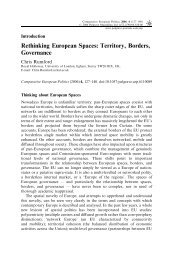Europeanisation, National Identities and Migration ... - europeanization
Europeanisation, National Identities and Migration ... - europeanization
Europeanisation, National Identities and Migration ... - europeanization
Create successful ePaper yourself
Turn your PDF publications into a flip-book with our unique Google optimized e-Paper software.
German trade unions <strong>and</strong> Polish migrant workers 203<br />
<strong>and</strong> pay: ‘Together with a growing permeability of the borders, irregular contract<br />
work <strong>and</strong> illegal employment are increasing. For both states considerable problems<br />
arise’ (Foundation Stone 90/2: 8). The membership magazine published the statement<br />
of the Berlin section of IG BAU complaining that employees of GDR-based<br />
enterprises were accepting jobs with poor conditions.<br />
In Berlin in particular, the local enterprises are just waiting to use the cheap<br />
subcontractors from the GDR <strong>and</strong> to reduce their permanent workforce. We<br />
Berlin construction workers can <strong>and</strong> will not compete with the ‘cheap-pay’<br />
[Billiglohn – a term with a pejorative undertone] in the GDR. This will be a<br />
competition between unequals. The local workers will not st<strong>and</strong> for the selling<br />
out of social <strong>and</strong> tariff protection. . . . The IG BAU therefore dem<strong>and</strong>s the<br />
restriction of the announced measures [i.e. the liberalisation of movement] on<br />
the free movement of goods only <strong>and</strong> to postpone the free movement of services<br />
until the framework [in East <strong>and</strong> West] has adjusted.<br />
(Foundation Stone 90/2: 8)<br />
With this statement, workers from the East, in this case citizens of the GDR, were<br />
classified as interlopers, lumped together with irregular contract workers or illegal<br />
workers, <strong>and</strong> stereotyped as unfair competitors. The claim of the Berlin section of<br />
IG BAU to maintain the legal barriers against citizens of the GDR in order to<br />
protect the workers in the West, was published without further editorial comment,<br />
although this very clearly formulated exclusionist attitude against compatriots<br />
had no legal basis. In the course of the political events of re-unification, the issue of<br />
the construction workers from East Germany received a new framing: in June 1990<br />
the federal executive board of IG BAU explained that the trade union would exp<strong>and</strong><br />
into East Germany in order to integrate East German workers into the organisation<br />
(Foundation Stone 90/5: 5). In some of the following issues, reports were published<br />
of East German workers accepting pay under the level of the tariff. But from now<br />
on, employers were held responsible for such occurrences.<br />
Employers <strong>and</strong> clients massively abuse the workers from the new federal Länder<br />
as price-reducers <strong>and</strong> ‘cheap-paid’. Public clients are no exception in this<br />
respect. . . . We make this dem<strong>and</strong>: equal pay for equal work on Western<br />
German construction sites.<br />
(Foundation Stone 92/2)<br />
After an initial exclusionist reflex, perceiving East German workers as outside<br />
interlopers, they were quickly accepted as a category which was difficult to integrate<br />
but impossible to exclude. The frame of reference shifted from rejection to solidarity.<br />
CEE contract workers as interlopers<br />
As expected, the construction industry enjoyed a boom period <strong>and</strong> the employ-ment<br />
situation improved. However, simultaneously, the number of foreign workers from<br />
East European countries increased as a result of the bilateral agreements on the



